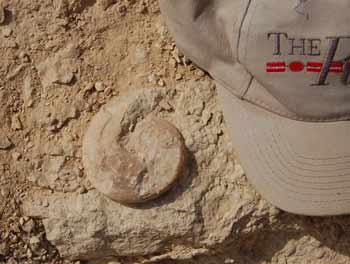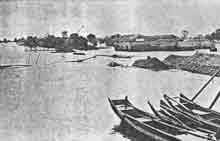|
The
story of Noah as recorded in Genesis was discredited as
knowledge was increased and geology
indicated no worldwide flood occurred. The
ancients lacked knowledge. There were fossils of
shells,
and other sea life in limestone, sandstone, and
shale on the mountains of the world including Israel.

Ammonite fossil, Akrabim
Pass, Negev Desert, Israel
|
Some of those
among the ancients may have attributed the presence of
fossils in the sedimentary rocks as derived from an
ancient flood that covered the entire earth. Only
a man with a boat for his family might have been
saved. We know the mountains were raised up
out of the depths of the sea and then torn down again by
erosion. The flood never covered the entire
earth. Tectonic stresses lifted ocean bottom onto
dry land over the course of millions of years. The
book of Genesis has generations going back a few
thousand years, but the world is billions of years old.
Before Genesis there was already a written legend
about a man living in house near a river warned of a
flood by a God who was able to forecast the future
before it happened. This testimony about
Ziasudra or Atrahasis was that God saved a man and his
family in contrast to the stories of the gods sending
famine, disease, and war to kill mankind. The
existence of an omnipotent God has been attested by
many, thus the appeal of a story about the ability of
an omnipotent spiritual being to warn of a coming
flood may seem credible to some according to their own
experiences.
|
In the areas where writing, agriculture,
engineering, literature and much of civilization advanced some
had knowledge of a God who possessed greater knowledge than
mankind. In Egypt it was written that a god had lived a
million years. In early Mesopotamia and Egypt there was already
some speculation of eternal life widely published. The
specialized knowledge of a few might have inspired many tall
tales, stories, and legends that were less than perfect. A
flood destroying hundreds of square miles and a man escaping it
by divine intervention is probable. There were numerous
typhoons striking India and Pakistan and these killed thousands
of people. The early trade connections between the Indus
River and Mesopotamia might have brought such a legend to
Mesopotamia. Otherwise the spring snow melt in the
mountains of Turkey or Iran accompanied by a late spring storm
along the Tigris or Euphrates River in May might been the
setting for the testimony of a time when God warned a man to
prepare for his salvation, and the faith of a man to believe and
be saved.
 |
This is a picture of flooding in China
during 1931. The flood covered 70,000
square
miles along the Yangtze and other major
rivers in China, affecting coastal lowlands
more than the mountains to the
west. A Chinese committee estimated 140,000
people died of drowning as dikes
broke. An estimated 420,000 more died of
famine
and disease. Field crops and as
many as 2,000,000 livestock were
lost. From a
report prepared for the US
Government by the Chinese Flood
Commission.
Floods killed more people than
earthquakes. People living along flood
risk rivers feared the floods that
caused devastation, yet needed the fertile bottom
land to survive. |
Reader
Commentary: dqhall59@yahoo.com
Some of Dave's other websites:
Israel Photos
Israel Photos II Web
Site
Israel Photos III
The Last
Supper
Was
Mt. Sinai a Volcano?
|

